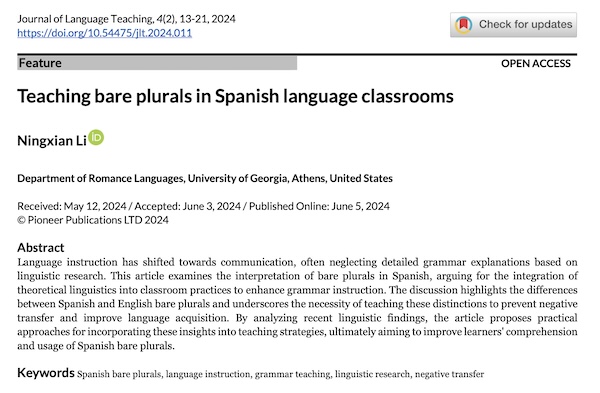Teaching bare plurals in Spanish language classrooms
DOI:
https://doi.org/10.54475/jlt.2024.011Keywords:
Spanish bare plurals, language instruction, grammar teaching, linguistic research, negative transferAbstract
Language instruction has shifted towards communication, often neglecting detailed grammar explanations based on linguistic research. This article examines the interpretation of bare plurals in Spanish, arguing for the integration of theoretical linguistics into classroom practices to enhance grammar instruction. The discussion highlights the differences between Spanish and English bare plurals and underscores the necessity of teaching these distinctions to prevent negative transfer and improve language acquisition. By analyzing recent linguistic findings, the article proposes practical approaches for incorporating these insights into teaching strategies, ultimately aiming to improve learners' comprehension and usage of Spanish bare plurals.
References
Alonso, A. (1967). Estudios lingüísticos: temas hispanoamericanos [Linguistic studies: Hispanic American themes]. Gredos.
Bosque, I. (1996). El sustantivo sin determinación: La ausencia de determinación en la lengua española [The noun without determination: The absence of determination in the Spanish language]. Visor Libros.
Carlson, G. (1977). Reference to kinds in English [Doctoral dissertation, University of Massachusetts Amherst]. https://scholarworks.umass.edu/dissertations/AAI7726414
Casielles-Suárez, E. (2004). The syntax-information structure interface: Evidence from Spanish and English. Routledge. DOI: https://doi.org/10.4324/9780203501719
Chierchia, G. (1998). Reference to kinds across languages. Natural Language Semantics, 6, 339-405. https://doi.org/10.1023/A:1008324218506 DOI: https://doi.org/10.1023/A:1008324218506
Chung, S. (2000). On reference to kinds in Indonesian. Natural Language Semantics, 8, 157-171. https://doi.org/10.1023/A:1026527925514 DOI: https://doi.org/10.1023/A:1026527925514
Condoravdi, C. (1994). Descriptions in context [Doctoral dissertation, Yale University]. https://ling.yale.edu/sites/default/files/files/CONDORAVDI.pdf
Contreras, H. (1986). Spanish bare NPs and the ECP. In I. Bordelolis, H. Contreras & K. Zagona (Eds.), Generative studies in Spanish syntax (pp. 25-49). Foris. DOI: https://doi.org/10.1515/9783110859232-004
Cuza, A., Guijarro-Fuentes, P., Pires, A., & Rothman, J. (2012). The syntax-semantics of bare and definite plural subjects in the L2 Spanish of English natives. International Journal of Bilingualism, 17(5), 634-652. https://doi.org/10.1177/1367006911435594 DOI: https://doi.org/10.1177/1367006911435594
DeMello, G. (1980). On the use of the article in Spanish. Hispania, 63(3), 557-560. DOI: https://doi.org/10.2307/341018
Dobrovie-Sorin, C. (1997). Existential arguments and existential predicates. In A. Ithaca (Ed.), Proceedings of Semantics and Linguistic Theory VII (pp. 117-134). CLS Publications. DOI: https://doi.org/10.3765/salt.v7i0.2796
Dobrovie-Sorin, C., & Laca, B. (1998). La génericité entre la référence à l’espèce et la quantification générique [Genericity between the reference to the species and generic quantification]. In P. Sauzet (Ed.), Actes de Langues et Grammaires III [Proceedings of Languages and Grammars III] (pp. 163–177). Université Paris.
Dobrovie-Sorin, C. & Laca, B. (2003). Les noms sans déterminant dans les langues romanes [Nouns without determiners in Romance languages]. In D. Godard (Ed.), Les langues romanes: problèmes de la phrase simple [Romance languages: simple sentence problems] (pp. 235-281). Editions du CNRS.
Doughty, C. & Williams, J. (1998). Pedagogical choices in focus on form. In C. Doughty and J. Williams (Eds.), Focus on form in classroom second language acquisition (pp. 197-261). Cambridge University Press.
Gregory, A. & Lunn, P. (2012). A concept-based approach to the subjunctive. Hispania, 95(2), 333-343. https://www.jstor.org/stable/23266216
Krifka, M. (2003, October). Bare plurals: Kind-referring, indefinites, both, or neither? Paper presented at the Fifth Paris Syntax and Semantics Colloquium. DOI: https://doi.org/10.3765/salt.v13i0.2880
Laca, B. (1996). Acerca de la semántica de los ‘plurales escuetos’ del español” [About the semantics of the ‘bare pluras’ of Spanish]. In I. Bosque (Ed.), El sustantivo sin determinación: La ausencia de determinante en la lengua española [The noun without determiner: The lack of determiners in the Spanish] (pp. 241-268). Visor Libros.
Laca, B. (1999). Presencia y ausencia de determinante [Presence and absence of determiners]. In I. Bosque and V. Demonte (Eds.), Gramática descriptiva de español [Descriptive gramar of Spanish] (pp. 891-929). Espasa Calpe.
Laca, B. (2013). Spanish bare plurals and topicalization. In W. Abraham and E. van Gelderen (Eds.), New perspectives on bare noun phrases in Romance and Beyond (pp. 95-120). John Benjamins Publishing. DOI: https://doi.org/10.1075/slcs.141.04lac
Lado, R. (1957). Language across cultures. University of Michigan Press.
Long, M. & Robinson, P. (1998). Focus on form: theory, research, and practice. In C. Doughty and J. Williams (Eds.), Focus on form in classroom second language acquisition (pp. 15–63). Cambridge University Press.
Mayoral Hernández, R. (2012). Teaching subject position in Spanish: Gustar verbs, unaccusatives and the impersonal passive. Journal of Language Teaching and Research, 3(2), 321-330. https://doi.org/10.1177/1367006911435594 DOI: https://doi.org/10.4304/jltr.3.2.321-330
McNally, L. (2004). Bare plurals in Spanish are interpreted as properties. Catalan Journal of Linguistics, 3, 115–133. https://doi.org/10.5565/rev/catjl.107 DOI: https://doi.org/10.5565/rev/catjl.107
Real Academia Española. (2009). Manual de la Nueva Gramática de la Lengua Española [Manuel of new grammar in Spanish]. Espasa Calpe.
Slabakova, R. (2006). Learnability in the second language acquisition of semantics: a bidirectional study of a semantic parameter. Second Language Research, 22(4), 498-523. https://doi.org/10.1191/0267658306sr277oa DOI: https://doi.org/10.1191/0267658306sr277oa
Suñer, M. (1982). Syntax and semantics of Spanish presentational sentence-types. Georgetown University Press.
Whitley, M. S. (2002). Spanish-English contrasts: A course in Spanish linguistics. Georgetown University Press.
Whitley, M. S & González, L. (2007). Gramática para la composición [Grammar for composition]. Georgetown University Press.
Van Geenhoven, V. (2000). Pro properties, contra generalized kinds. In B. Jackson and T. Matthews (Eds.), Proceedings from semantics and linguistic theory X (pp. 221-238). CLC Publications. DOI: https://doi.org/10.3765/salt.v10i0.3112
VanPatten, B. (2002). Processing instruction: An update. Language Learning, 52(4), 755–803. https://doi.org/10.1111/1467-9922.00203 DOI: https://doi.org/10.1111/1467-9922.00203
VanPatten, B. (2004). Input processing in second language acquisition. In B. VanPatten (Ed.), Processing instruction: Theory, research, and commentary (pp. 5–31). Lawrence Erlbaum and Associates.

Downloads
Published
Issue
Section
License
Copyright (c) 2024 Journal of Language Teaching

This work is licensed under a Creative Commons Attribution 4.0 International License.




